Energy Efficiency and Resilience of Building and Renovating With Propane
Exploring propane’s energy advantages for residential renovations and new construction
Sponsored by Propane Education and Research Council | By Amanda C Voss, MPP

Photo courtesy of Propane Education & Research Council
Clean, domestic energy is a reality for residential projects choosing propane.
Imagine a product that increases access to clean, affordable, reliable energy for any home. Or a product that reduces carbon emissions while dependably meeting energy needs.
The compelling force behind many traditional sustainability and energy programs has been reducing the operational energy consumption of buildings. However, as buildings grow more energy efficient, the embodied environmental impacts stemming from production, construction, maintenance, and disposal of building materials or products represent an increasing share of a building’s total environmental burden.
Fortunately, having a product that provides accessible energy in a responsible manner is a reality that does not have to wait on the progress of science or technological innovation. It exists today, in the form of propane.
Propane is a low-carbon energy source that produces fewer harmful emissions than competing fuels. According to the US Office of Energy Efficiency and Renewable Energy (EERE), 52% fewer greenhouse gas emissions are released when using propane, as compared to an equivalent amount of electricity generated from the U.S. grid.1 In analyzing residential heating needs, 50% fewer greenhouse gas emissions (GHG) are produced from residential propane furnaces than from all-electric models.2 Propane combustion is also cleaner than heating oil, resulting in lower CO2 emissions, 12 percent fewer greenhouse gas emissions, and 80 percent fewer NOx emissions, when compared with a heating oil furnace.
Propane is extremely energy efficient, especially when compared to other energy sources. Liquid propane has a higher energy density than ethanol, methanol, and liquefied natural gas, meaning propane vehicles go farther on a tank of fuel than most other liquid alternative fuels, assuming comparable equipment efficiency. This energy density benefits home appliances powered by propane. A standard propane water heater with a tank performs more efficiently than a standard electric water heater with a tank. An ENERGY STAR storage tank propane water heater can save a household 13-16% on heating costs over a year, as compared to an efficient electric model. In a 2,400-square-foot home, an electric water heater would cost the homeowner about $645 a year, whereas a propane heater would cost only $290 a year. That adds up to annual savings of about $355 a year.
Propane has an exceptional environmental profile. Still, no energy source can be considered completely “clean.” Even energy sources labeled as renewable, like solar, wind, and hydroelectric, have environmental challenges. However, when carbon emission levels are used as a benchmark, propane remains one of the cleanest fuels available. In comparison to other widely used fuels, the US Energy Information Administration (EIA) shows that propane offers one of the lowest carbon emissions per million BTUs.3 Put into perspective, over its lifespan a storage tank propane water heater produces 46% fewer greenhouse gas emissions. A propane tankless water heater sends about 70% fewer emissions into the atmosphere. A tankless water heater, powered by propane, can last anywhere from 15 to 20 years with proper maintenance and operation. In comparison, a standard tank water heater normally has a working life of 10 years or less. Besides efficiency, propane tends to be a more affordable energy option. While fuel costs fluctuate, propane is generally cheaper per BTU compared to oil, according to the U.S. Energy Information Administration (EIA).
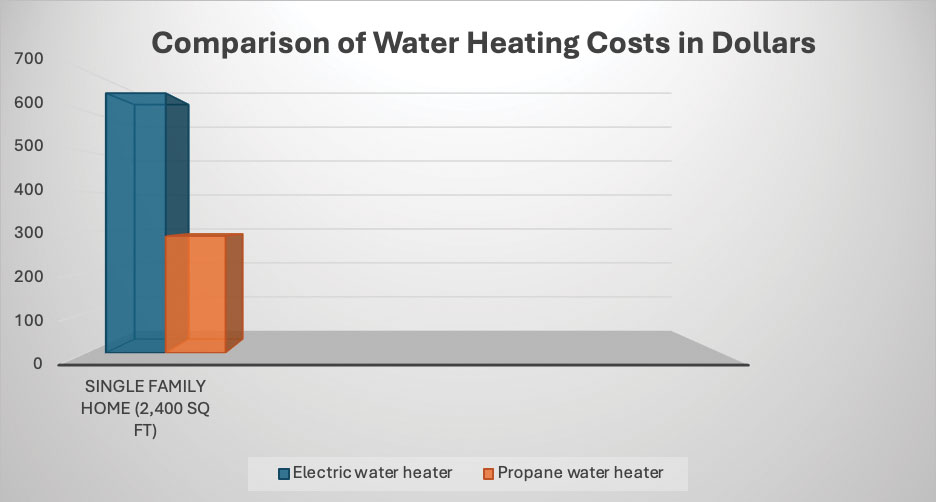
Data courtesy of Propane Education & Research Council
Comparison of annual costs for an average single-family home using propane water heating, displayed in orange, versus electric water heating, displayed in blue.
In addition to environmental performance, propane proffers excellent environmental benefits once on site. Propane is stored as a liquid, but when released into the air, it vaporizes and dissipates–which means it won’t contaminate groundwater, drinking water, marine ecosystems, or other sensitive habitats. When vaporized, propane produces virtually no ozone-harming effects and, unlike natural gas, it is not a greenhouse gas in its un-combusted state. Because of these advantages, propane is a preferred fuel source in environmentally sensitive areas like nature preserves and national parks.
Using propane as a fuel or energy source means harnessing an available clean technology to reduce emissions while still meeting energy needs. Propane is clean and non-toxic. Propane is abundantly available, and the growth of renewable propane technology means it can be used sustainably for generations to come.
REALIZING PROPANE’S ADVANTAGES TODAY
Propane is a high-performing, safe, and cost-effective energy source. Propane has lower carbon emissions than natural gas, fuel oil, diesel, and even electricity. In fact, 60% of the U.S. electric grid is still powered by natural gas or coal, which has high carbon emissions. Propane is a domestic resource and in high supply, so pricing is consistent and competitive with other energy sources.
Currently, 12 million U.S. households use propane for space heating, water heating, or cooking. Since propane-powered appliances are energy-efficient, homeowners save on energy costs and minimize their consumption. Many states and municipalities offer incentives for using clean alternative fuels, including propane. For the homeowner, propane is an exceptionally stable fuel source. Power from propane is often cheaper than electric power and offers better price stability, which translates into predictable energy bills.
When specifying equipment for a new home, or a home under renovation, the design professional is committing to a decision that will have energy and performance implications for 20 years or more. Selecting appliances and equipment that use propane as a fuel source provides confidence that today’s decision can reduce emissions immediately, with the prospect of enhanced reduction and costs in the future.
Addressing the Limitations of Electricity
All things electric, from vehicles to appliances, are currently in the spotlight. As oil prices peak, another electric power is spurring additional consumer interest in the Northeast: using electric heating to supplant fuel oil. Design teams, builders, and contractors are increasingly navigating energy source discussions with their clients.
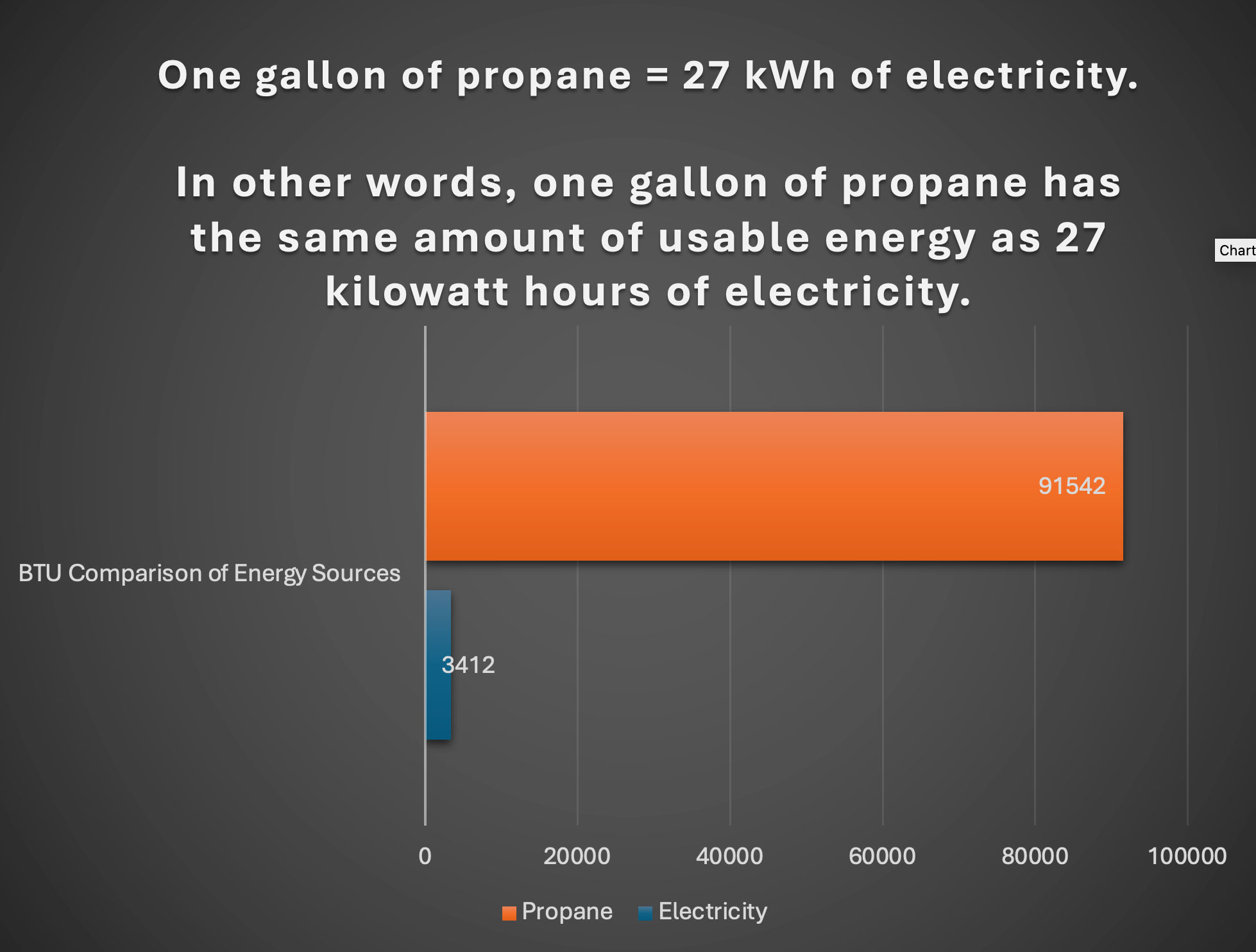
Data courtesy Propane Education & Research Council
Comparison of usable energy, as measured in British Thermal Units (BTUs), in propane versus electricity.
It is important to understand that switching to electricity does not automatically mean de-carbonization. Electricity must be generated by a primary energy source and in the US, natural gas and coal are electricity’s largest primary energy sources. Because electricity is a secondary energy source, generated using a primary energy source, labeling electricity as the most environmentally friendly energy available is far from accurate. Furthermore, once generated, electricity must be transmitted through power lines, where electrons encounter resistance and lose energy. This means that getting one unit of electricity to wherever the plug is located can consume up to three units of source energy.
Propane offers a much different equation for the homeowner. According to the US Department of Energy’s (DOE) ENERGY STAR program, propane has a source-site ratio of 1.01. It is delivered on site, rather than transmitted or piped, so virtually no energy is lost in the transfer. Plus, propane’s storage flexibility means sensitive habitats can remain undisturbed, eliminating the need for pipelines or high-voltage power line installations.
Propane installations are governed by NFPA 54. NFPA 54/ANSI Z223.1, National Fuel Gas Code, offers the latest comprehensive provisions for the safe design, installation, operation, maintenance, purging, and inspection of gas piping, equipment, accessories, and appliances supplied with fuel gas. The code covers piping system design, materials, and components, pipe sizing and installing pipes underground, above ground, and inside concealed spaces, and piping inspection, testing, system leak check, and purging. NFPA also addresses requirements for process air and installation of appliances and minimum safe performance criteria, general requirements, and specifications for venting combustion products. NFPA provides the industry benchmark for safe storage, handling, transportation, and use. Adhering to the provisions mitigates risks and ensures safe installations that prevent failures, leaks, and tampering.

Figure courtesy of Propane Education & Research Council
Propane brings exceptional clean energy benefits to the table, including distinct reductions in harmful emissions.
Efficiency standards are part of IECC and subject to the version a jurisdiction has adopted. The measured efficiency of propane-powered appliances adds further support for propane’s sustainability. Compared with an electric system, a tankless propane water heater can save up to 50% on energy costs, which translates to significantly lower environmental impact. Propane tankless water heaters are 34% more efficient than conventional storage water heaters. Propane fireplaces produce fewer particulate emissions, and less carbon monoxide compared with wood-burning fireplaces and are more environmentally friendly than electric fireplaces. Both high-efficiency propane furnaces and propane tankless water heaters can be key components in earning the LEED for Homes (LEED H v4) and the 2015 National Green Building Standard (NGBS) certifications for a home. High-efficiency propane furnaces and water heaters can reduce a home’s HERS Index by anywhere from 9 to 14 points.
Building a Resilient Home
Power outages are becoming a more frequent fact of life. On average, U.S. electricity customers experienced approximately five and one-half hours of electricity interruptions in 2022, according to the U.S. EIA’s recently released Annual Electric Power Industry Report.7 While weather has always been a leading cause of power outages, the number of weather-related outages has escalated dramatically in recent years, increasing by approximately 78% between 2011-2021 when compared with the previous decade, according to data compiled by Climate Central. Residents in Texas, Michigan, California, North Carolina, and Pennsylvania are particularly vulnerable, as these states suffer the largest number of weather-related power outages.

Figure courtesy of Propane Education & Research Council
Propane brings exceptional clean energy benefits to the table, including distinct reductions in harmful emissions.
According to the DOE, outages are also lasting longer. A power outage can place a heavy burden on a family. Even short outages, lasting less than four hours, cost homeowners an average of $1,250. Still, only 27 percent of homeowners report having any source of backup power.
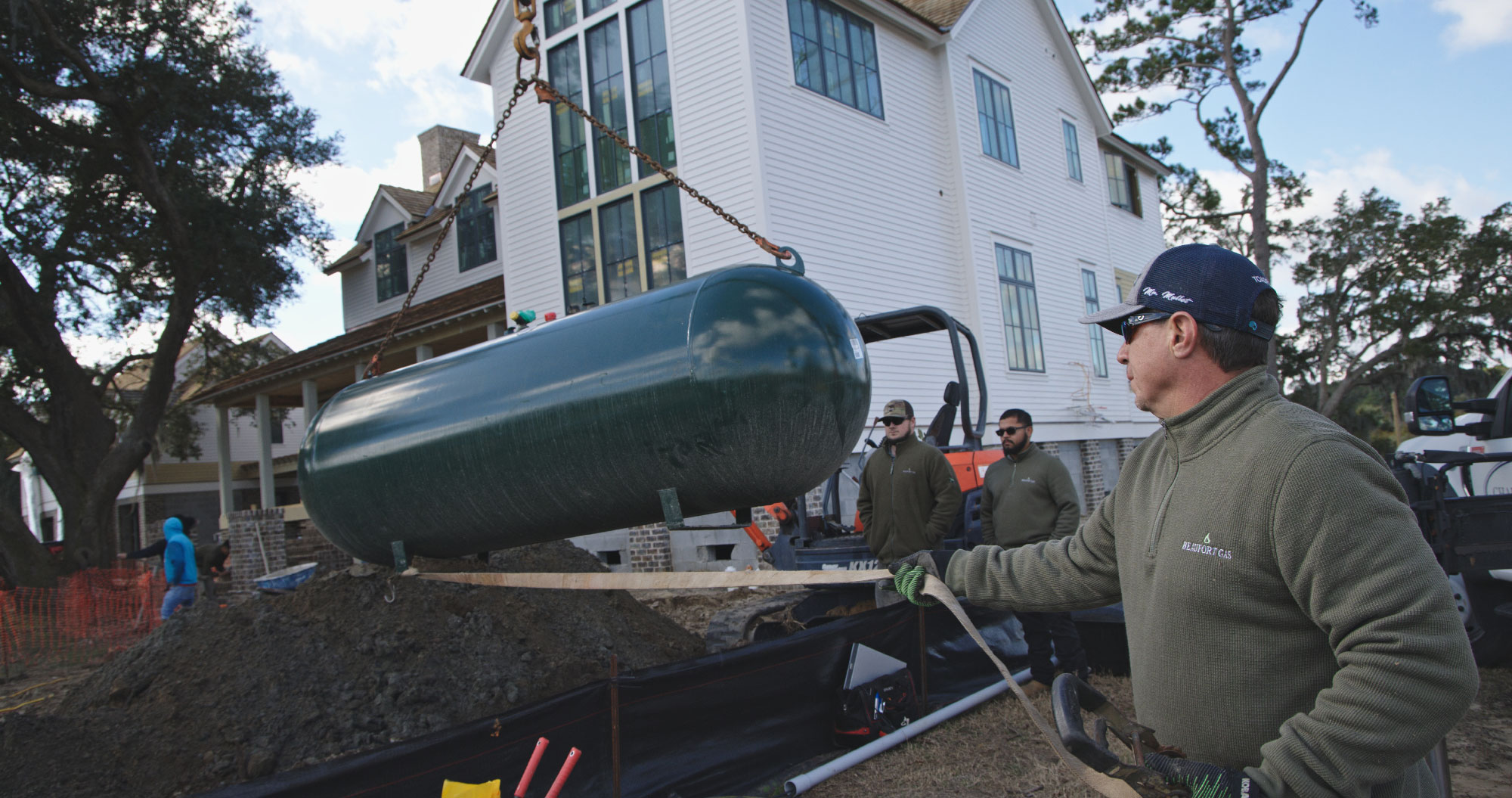
Photo courtesy of Propane Education & Research Council
Having energy on site provides reliable peace of mind for homeowners.
In areas where natural disasters occur, many builders have discovered the value of marketing more durable homes. This is certainly true for net zero or off-grid homes that may utilize multiple forms of power, including solar and wind. Propane standby generators offer a powerful, reliable way to protect homes and families, as well as buildings and businesses, from the damage a power outage can cause. A standby generator powered by propane offers definite advantages over other fuel source generators. Propane doesn’t degrade over time, unlike diesel or gasoline, making it an ideal standby power fuel. Propane produces significantly fewer greenhouse gas emissions than diesel or gasoline and is non-toxic, non-poisonous, and won’t contaminate soil or water. Propane can handle an entire home’s energy needs for days, unlike solar- or wind-powered systems. Permanently installed and supplied by an above- or below-ground tank, a propane standby generator starts automatically, the moment the power goes down, supplying supplemental electricity in as little as 10 seconds after an outage. A propane standby generator provides homeowners heating and cooling, lighting, refrigeration, and the amenities their neighbors are without after the power is knocked out. A reliable propane standby generator can be a key part of resilient, self-contained energy design, which allows a house to continue providing the primary function of a home after a disaster. On-site generators allow a home to resist hazards brought on by major disasters, such as damage to appliances or electronics, spoiled food, loss of heat or air conditioning, hotel costs, and more. Resilience through on-site power reduces the magnitude or duration of a disruptive event to a property and the impact on homeowners.
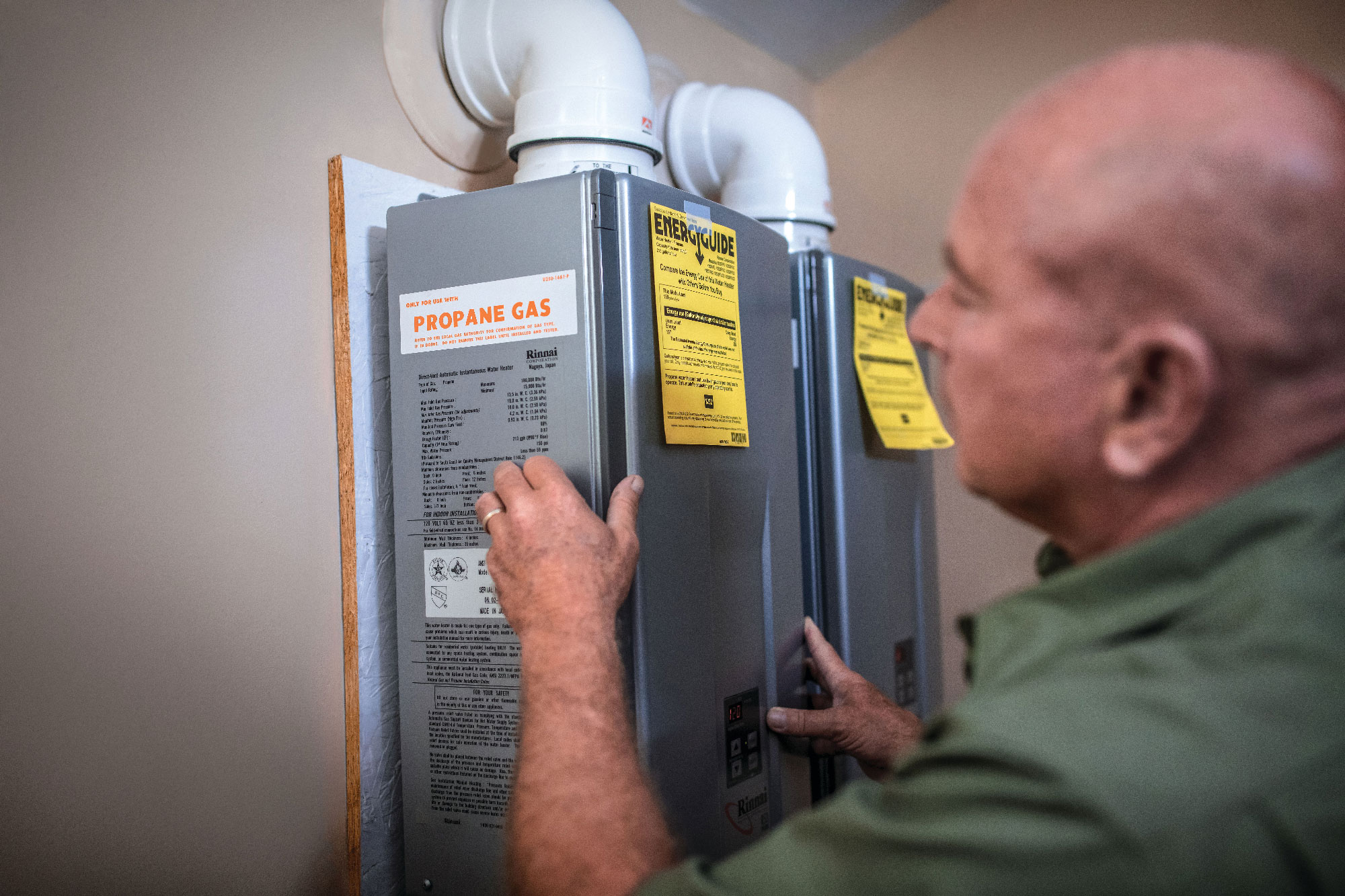
Photo courtesy of Propane Education & Research Council
Propane water heaters, furnaces, and boilers use less energy, cost less to operate, and have fewer emissions as compared to electric models.
REMODELING WITH PROPANE FOR EFFICIENCY AND ECONOMY
In the winter of 2023–2024, about 4.79 million households in the United States used heating oil (distillate fuel oil) as the primary heating fuel, and about 82% of those households were in the U.S. Northeast Census Region, according to the EIA.8
Heating oil and diesel fuel are closely related petroleum products called distillates. Heating oil is sold mainly for use in boilers and furnaces, for space heating, and in water heaters. Nearly all of the heating oil consumed in the United States is produced from crude oil, making it an expensive and carbon-heavy fuel source.
Heating oil systems can be converted to propane today and have an immediate impact on reducing emissions. Additionally, choosing a propane conversion instead of an electric conversion reduces the installation and operating cost, when compared to electrical equipment.
Conversion from heating oil to propane is easy, inexpensive, and reduces emissions. In designing new systems or replacing current heating oil boilers and furnaces, the propane HVAC equipment will have a similar footprint, but higher efficiencies and eliminate the environmental risk of spilled oil. Propane is better for the environment, with systems producing 12 percent fewer greenhouse gas emissions and 80 percent fewer NOx emissions compared with a heating oil furnace. Like heating oil, propane is stored on site, providing security and independence for homeowners. Propane systems have lower overall energy costs compared with heating oil systems. Comfortable, consistent warmth is not the only benefit of a propane heating systems. Propane gives homeowners additional flexibility, beyond home heating. It can provide exceptional energy performance in water heating, cooking, clothes drying, fireplaces, and backup power generation applications. Its versatility far exceeds the limitations of fuel oil.
Confronting the cost of any energy conversion is a reality. While propane is cheaper than oil for home heating, some homeowners may question the upfront costs of converting fuel sources. Switching to propane is not a small investment, but the payoffs can be big. Given current oil prices, payback for the average conversion project can be expected within 2 to 3 years. That is an expedited timeline compared with years past, when oil prices were lower. Propane suppliers also emphasize the benefits beyond space heating, once propane is onsite. Propane can be added to fuel gas stoves, dryers, backup generators, and water-heating appliances, helping curb electricity costs. Not only is propane a less expensive fuel than oil, but furnaces and boilers powered by it are more efficient than their oil-fueled counterparts and have lower annual maintenance costs. Another benefit of propane is reduced insurance costs. Most homeowner policies do not include coverage for an oil spill, forcing owners to purchase separate liability insurance to guarantee protection in the case of a toxic spill. The impact of a home heating oil spill can be devastating, with oil seeping into the soil and causing damage that can require extensive soil remediation. With propane, this risk is eliminated. A propane release is very rare, but if it does happen and propane is released into the air it can dissipate harmlessly.
Any remodeling conversation should also factor in costs avoided. When evaluating switching from oil to electricity, homeowners have to calculate transitioning from 60 to 100 amperage service up to 200 and 400 amps. That upgrade alone can cost more than $6,000, even before new equipment costs and retrofit costs are factored in. However, selecting propane as a replacement for fuel oil means avoiding the need to increase amperage while providing efficiencies of 98 percent or more. For reference, heating oil furnaces typically provide efficiencies between 60 and 80 percent.
While the ultimate goal for many homeowners is to lower utility bills and improve comfort, making the switch to propane brings several additional benefits. Many homeowners are relieved to rid their basements of a 200-plus-gallon oil tank, freeing up square footage and eliminating the potential for toxic leaks. Whether the space relies on space heating, forced air heat, or a boiler, heating with propane creates a healthier indoor environment and more comfortable heat. Oil furnaces also require considerably more maintenance due to the buildup of soot and carbon. “That’s an energy cost in my opinion,” says Tom Soukup, principal of Patriot Water Heater Co. in Lancaster County, Pennsylvania. “Gas is cleaner and easier to maintain. Overall, propane is a much better solution than using oil.” Oil furnaces can be vented only one way: up. That can present installation challenges. Propane furnaces are more flexible because they can use existing vent paths or vent out of a side wall. More homeowners are also prioritizing the environment. Compared with oil, propane for space heating is the greener option, producing 38 percent fewer greenhouse gases.
CAPTURING A RENEWABLE FUTURE WITH PROPANE
4Using propane as an energy source means harnessing an available clean technology to reduce emissions while still meeting energy needs. Propane is clean and non-toxic. Propane is abundantly available, and the growth of renewable propane means it can be used for generations to come.
Accelerated Efficiency on the Horizon: Renewable Propane
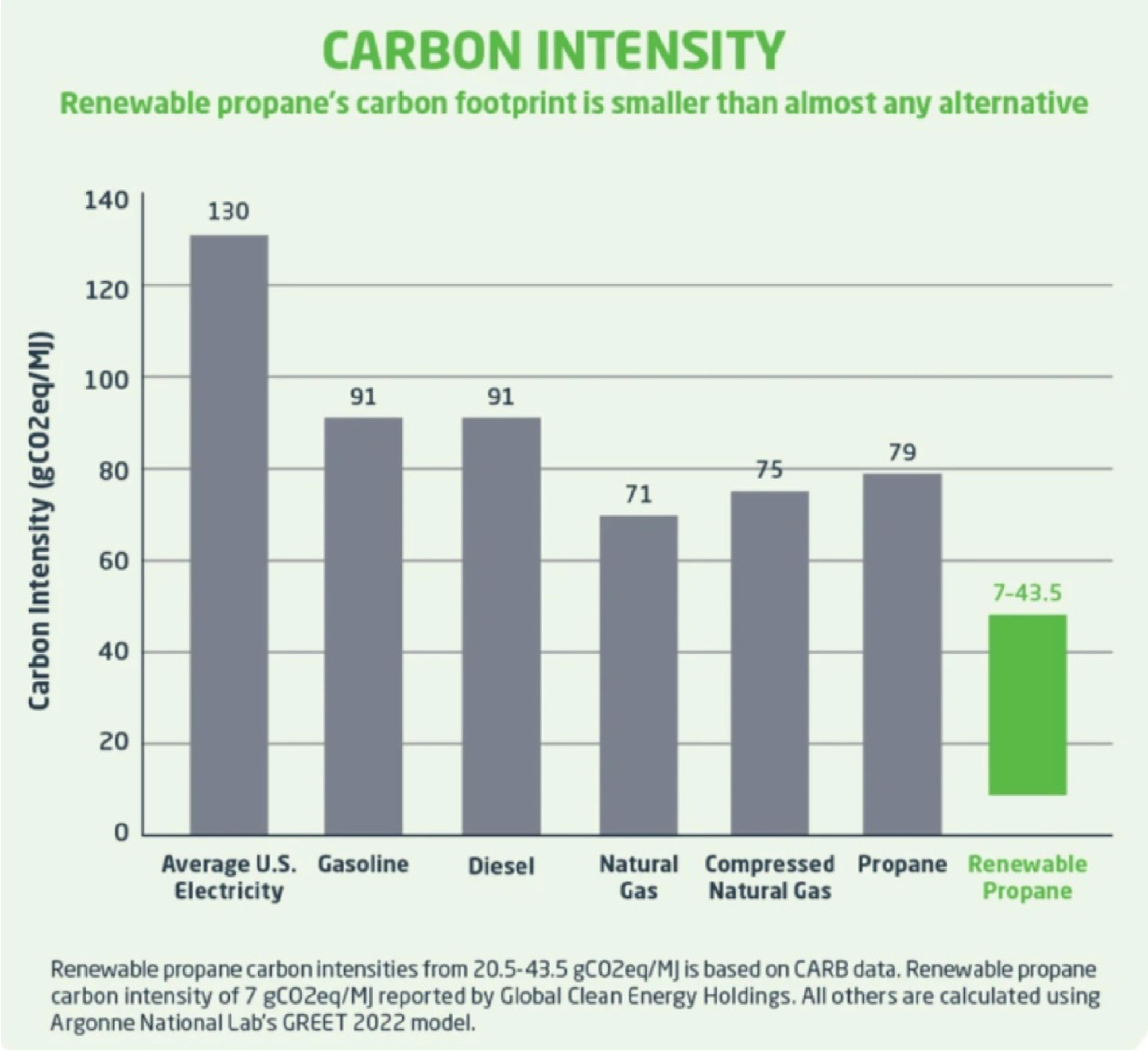
Figure courtesy of Propane Education & Research Council
Comparison of the amount of carbon dioxide (CO2) emissions produced per unit of energy of major fuel sources.
“Propane is clean today and even cleaner tomorrow.”
Renewable propane provides a truly renewable energy source because it is made by converting plant and vegetable oils, waste greases, and animal fat into fuel. This not only circumvents disposal of waste grease and oil, but it also allows for a circular energy source.9 Renewable propane has the same great features as conventional propane—reliability, portability, power, and reduced carbon emissions—but with even lower carbon emissions when compared with other energy sources.
While the most common form of renewable propane today is a byproduct of renewable diesel and sustainable aviation fuel produced from used cooking oil, more and more renewable propane is being generated from the seed oil of the camelina plant. Also known as camelina sativa or false flax, camelina is a member of the mustard family and a relative of cabbage, kale, and cauliflower. Camelina oil is a new source for renewable diesel and produces renewable propane with the lowest carbon intensity currently available. Critically, camelina is not a food crop, nor does it compete with food production. Camelina is a cover crop and is completely waste-free. The seed produces 40% oil (twice the amount yielded by soybean), the remaining meal is FDA approved for cow and chicken feed, and the husks are used for mulch. The camelina plant is beneficial for farmers because it enriches the soil and prevents erosion when fields are fallow and provides additional income without the need for new equipment.
Renewable propane delivers a high-energy conversion so that BTUs aren’t wasted, and it is price competitive. At the point of combustion, renewable propane is carbon neutral, meaning that no new carbon is added to the atmosphere when renewable propane is burned. Renewable propane has an ultra-low carbon intensity; as low as 19, or 7 with a meal credit. Under a meal credit, the seed oil is used for fuel and the remaining plant fiber is used for feedstock. By comparison, the average carbon intensity score for electricity in the U.S. is 130. Because renewable propane’s chemical structure and physical properties are the same as conventional propane, renewable propane can be used for all the same applications without needing any system or equipment changes.
U.S. fuel processors are making renewable propane today, and the push for cleaner liquid fuels such as sustainable aviation fuel and renewable diesel fuel, will lead to a sharp increase in renewable propane production.
SUMMARY
Choosing propane for a residential project secures forward-thinking environmental benefits, including reduced greenhouse gas and NOx emissions, as well as lowered energy costs. The energy density of propane allows home equipment and appliances to perform more efficiently. Since propane is designed to be safely delivered and stored on site, it offers energy security. The security, efficiency, and environmental profile of propane provide it with unique advantages when compared against other energy sources, like electricity or heating oil. With its flexibility, propane provides a good match for renovation projects seeking greater efficiency. Propane is ultimately an adaptable and high-performance energy source for any home’s portfolio, capable of contributing to net zero energy homes and environmental qualifications, including LEED for Homes (LEED H v4) and the 2015 National Green Building Standard (NGBS).
END NOTES
1GREET 2021. https://www.energy.gov/eere/greet.
2GTI Report.
3Carbon Dioxide Emissions Coefficients. U.S. Energy Information Administration. September 7, 2023. https://www.eia.gov/environment/emissions/co2_vol_mass.php. Accessed July 24, 2024.
4(2021) EPA - CHP Benefit. https://www.epa.gov/chp/chp- benefits
5https://www.axiom-energy.com/_files/ugd/7a0ad4_a74da8efef054a6e9030649827b90169.pdf?index=true. Accessed August 8, 2024.
6“U.S. electricity customers averaged five and one-half hours of power interruptions in 2022.” Today in Energy. U.S. Energy Information Administration. January 25, 2024. https://www.eia.gov/todayinenergy/detail.php?id=61303#:~:text=On%20average%2C%20U.S.%20electricity%20customers,in%202022%20compared%20with%202021. Accessed July 25, 2024.
7“Heating oil explained.” U.S. Energy Information Administration (EIA). https://www.eia.gov/energyexplained/heating-oil/use-of-heating-oil.php#:~:text=Who%20uses%20heating%20oil%3F,the%20U.S.%20Northeast%20Census%20Region. Accessed July 30, 2024.
8(2021) Renewable Propane as a Sustainable Fuel Solution in California. https://www.gladstein.org/renewable-propane- sustainable-fuel-solution-california/.
Amanda C Voss, MPP, is an author, editor, and policy analyst. Writing for multiple publications, she has also served as the managing editor for Energy Design Update.
The Propane Education & Research Council is a nonprofit that provides leading propane safety and training programs and invests in research and development of new propane-powered technologies. PERC programs benefit a variety of markets including residential and commercial building.
Originally published in Architectural Record
Originally published in September 2024
LEARNING OBJECTIVES
- Evaluate the environmental benefits provided to a project by propane, including reduced greenhouse gas and NOx emissions and lowered energy costs.
- Conduct a thorough comparative analysis of propane-fueled systems through the lens of energy and performance.
- Outline the profile of environmental and cost advantages for a renovation project when converting from heating oil to propane.
- Validate why propane is both an adaptable and renewable energy source, as well as demonstrate how this fuel contributes to net zero energy homes and environmental qualifications, including LEED for Homes (LEED H v4) and the 2015 National Green Building Standard (NGBS).












